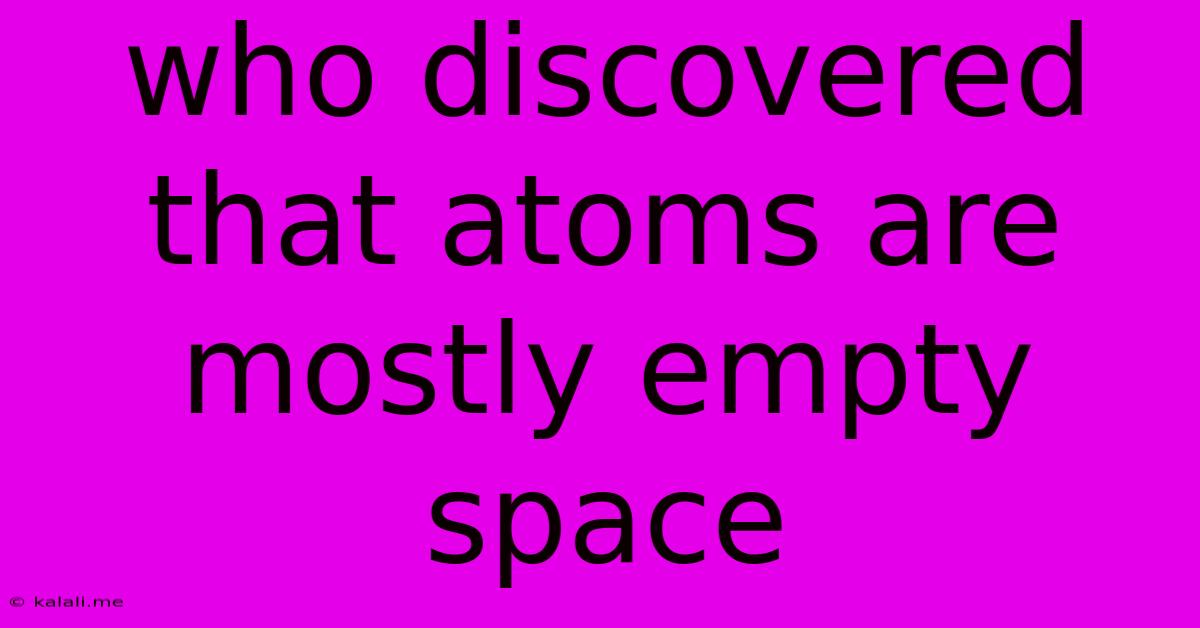Who Discovered That Atoms Are Mostly Empty Space
Kalali
May 09, 2025 · 3 min read

Table of Contents
Who Discovered That Atoms Are Mostly Empty Space? The Astonishing Story of the Gold Foil Experiment
The idea that atoms are mostly empty space is a cornerstone of modern physics, radically altering our understanding of matter. But who deserves the credit for this groundbreaking discovery? While the concept wasn't a "eureka!" moment for a single person, the gold foil experiment, conducted by Ernest Rutherford and his team in 1909, provided the conclusive evidence that shattered the prevailing model of the atom. This experiment revealed the atom's surprisingly spacious structure, paving the way for our current understanding of nuclear physics.
This article will delve into the history of atomic theory, leading up to Rutherford's pivotal experiment, and explain how it demonstrated the atom's largely empty nature. We'll also touch upon the contributions of other scientists whose work laid the groundwork for this crucial discovery.
The Pre-Rutherford Atom: A Solid Sphere?
Before Rutherford's work, the prevailing model of the atom, proposed by J.J. Thomson, was the "plum pudding" model. This depicted the atom as a positively charged sphere with negatively charged electrons embedded within it, much like plums in a pudding. This model, while a significant step forward, suggested a relatively uniform and solid structure, with no significant empty space.
Enter the Gold Foil Experiment: A Revolutionary Approach
Rutherford's experiment was remarkably simple in its design but profoundly impactful in its results. Alpha particles (positively charged particles) were fired at a thin gold foil. According to the plum pudding model, these particles should have passed straight through the foil with only minor deflections.
However, the results were astonishing. While most particles did pass straight through, a small percentage were deflected at large angles, and some even bounced directly back! This unexpected outcome completely contradicted the plum pudding model.
The Nucleus Takes Center Stage: Interpreting the Results
Rutherford's team carefully analyzed these results. They realized that the large deflections could only be explained if the positive charge of the atom was concentrated in a tiny, dense region at the atom's center – the nucleus. The vast majority of the atom, therefore, had to be empty space, with electrons orbiting this central nucleus.
This model, known as the Rutherford model, or the nuclear model, revolutionized atomic theory. It provided the first accurate picture of the atom's structure, emphasizing the significant amount of empty space within it.
Beyond Rutherford: Building on the Foundation
It's crucial to remember that Rutherford didn't work in a vacuum. The work of scientists like J.J. Thomson (discovering the electron), and Henri Becquerel (discovering radioactivity), which provided the fundamental building blocks for understanding atomic structure, were essential precursors to Rutherford's experiments. Similarly, later developments, such as Bohr's model of the atom, further refined our understanding of electron behavior and atomic structure.
Conclusion: A Legacy of Empty Space
The discovery that atoms are mostly empty space was not a single moment of insight but a process of scientific inquiry built upon the contributions of numerous scientists. However, Ernest Rutherford's gold foil experiment stands as the pivotal moment that conclusively demonstrated this astonishing fact. His groundbreaking work laid the foundation for our modern understanding of atomic structure and nuclear physics, shaping our knowledge of the universe at its most fundamental level. The seemingly empty space within atoms is, in reality, a realm of quantum mechanics, brimming with complex forces and interactions that continue to fascinate and challenge scientists today.
Latest Posts
Latest Posts
-
Is Sulfuric Acid An Element Compound Or Mixture
May 09, 2025
-
Is Gold A Compound Element Or Mixture
May 09, 2025
-
What Is Heat Energy Indirectly Measured By
May 09, 2025
-
Negative Fraction Times A Negative Fraction
May 09, 2025
-
How To Tell If A Reaction Is A Redox Reaction
May 09, 2025
Related Post
Thank you for visiting our website which covers about Who Discovered That Atoms Are Mostly Empty Space . We hope the information provided has been useful to you. Feel free to contact us if you have any questions or need further assistance. See you next time and don't miss to bookmark.